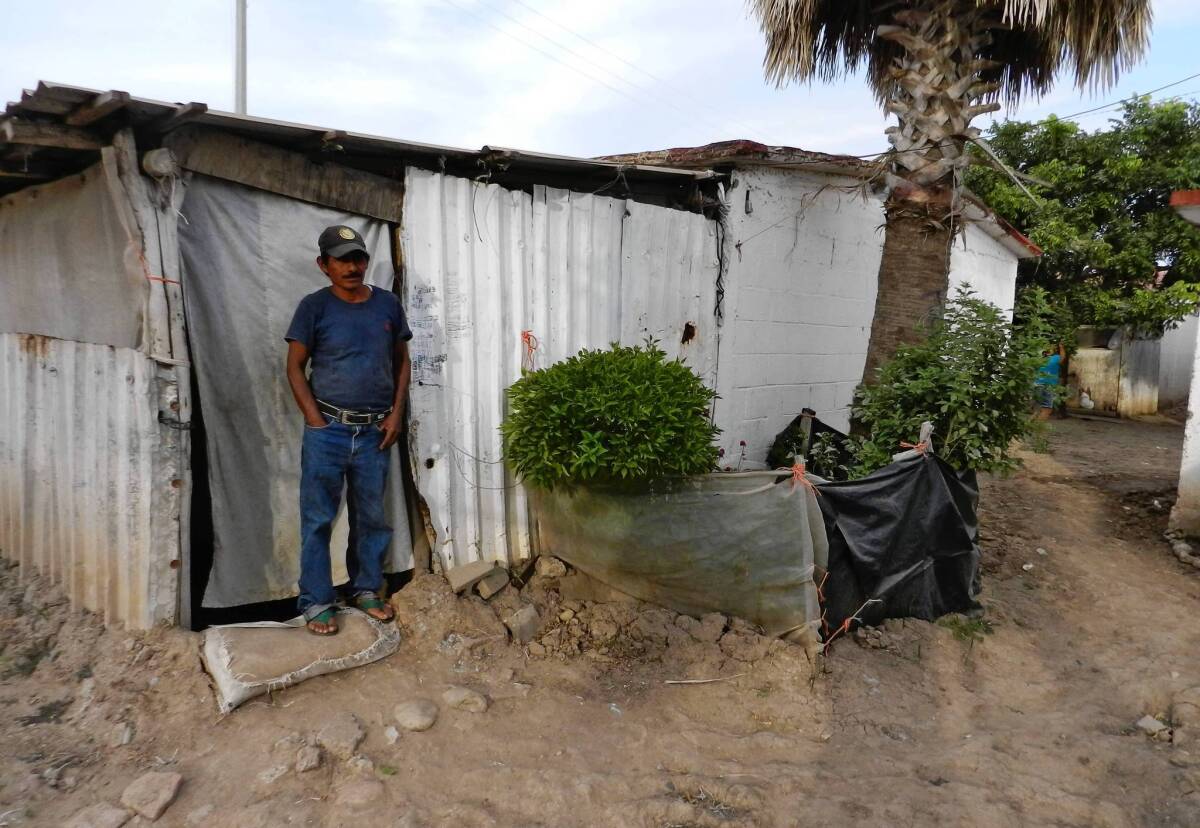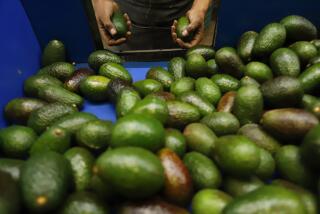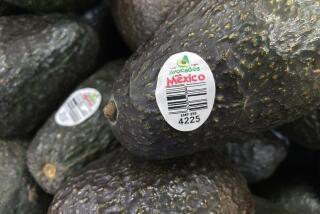Mexico’s tomato-farm workers toil in ‘circle of poverty’

VILLA JUAREZ, Mexico — They sure do have tomatoes here in the Mexican state of Sinaloa.
Elongated red ones. Round green ones. Cherry tomatoes, yellow tomatoes, grape tomatoes.
Vast fields of tomatoes, lining the roads out of the Sinaloa capital of Culiacan, miles and miles of mesh tenting shielding the plants from the sun.
Last year, Sinaloa exported 950,000 tons of vegetables, mostly tomatoes and mostly to California and other parts of the United States, worth nearly $1 billion. Half the tomatoes eaten in the United States this time of year are from Sinaloa. The tomato is the symbol on the Sinaloa license plate.
But while a short list of landowners make millions, the planting, weeding, pruning and picking of the vegetables fall to armies of workers from Mexico’s poorest states — Oaxaca, Guerrero, Chiapas — who have little opportunity for schooling or other forms of legal employment.
So they are here in these fields, recruited by enganchadores — or “hooks” — who round them up in their home villages, and working in conditions that vary from producer to producer but that many critics say amount to indentured servitude.
Felipa Reyes, 40, from the violent state of Veracruz, has been toiling in the fields of Sinaloa for seven years. “You have to do the work they want, or you don’t earn anything,” she said. Complain? “And I’d end up with nothing.”
Carmen Hernandez Ramos is 52 and looks 80. She has been sticking tiny tomato plants into the earth, then harvesting the fruit months later, for 15 years, but still earns the same daily wage as Reyes: $10. Originally from a small village in Oaxaca, the mother of six works back-wrenching nine-hour days. “If we work, we have security,” she said, waving her thick-knuckled hands. “If we don’t, we have nothing.”
The two women live in tin-roofed adobe shacks set behind chain-link fences.
Conditions, the women said, have changed little over the years. They have electricity but no running water; some floors are tiled, others are dirt.
The 50 or so families living in this compound under billboards for DuPont Chemical’s Agriseeds and Gruindag triple-action insecticides share open-air toilets and showers.
Known as jornaleros — literally “day laborers” — they are mostly from indigenous, rural communities. Most speak little Spanish.
Recruited in their hometowns and loaded onto buses for 30-hour drives to Sinaloa, many recent arrivals say they feel deceived about the conditions, opportunities and pay that awaited them. Once in Sinaloa, they say, they feel trapped — housed in fenced compounds far from actual towns with movement restricted for what owners say are security reasons.
Many say the farmers refuse to pay them until the end of the season, obliging them to stick it out; in the meantime, they buy tortillas, cooking oil and other supplies on credit from small stores owned by their employers.
“They know their rights but can’t talk about it: They’d be out of a job the next day,” said Cresencio Ramirez, 32, a Triqui Indian from Oaxaca who managed to alternate picking tomatoes and jalapeno peppers with schooling, eventually earning a law degree.
As a member of the Democratic Network of Indigenous Pueblos, he is allowed to visit farmworkers but, he says, is restricted in what he may talk about. Labor law is not on the approved list.
“They have no freedom of choice” to come and go from the farm, change jobs or speak out about it, he added.
Farm owners counter that they have made steady improvements. In the last couple of decades, they say, workers increasingly bring their entire families; even mayors join the exodus to the fields.
Although most laborers return to their hometowns at the end of the season, which tends to extend from the Day of the Dead in November to Holy Week before Easter, more have begun to settle permanently in Sinaloa in places such as Villa Juarez, now in essence a roadside slum with slightly steadier housing and about 20,000 residents.
By law, the growers are now required to provide schools, nurseries and healthcare for the estimated 150,000 jornaleros (down from 250,000 25 years ago) and allow inspections by social workers. The social workers, however, are usually on the farm owners’ payroll.
By most accounts, child labor has lessened, with fewer minors under the age of 14 found working in the fields. A decade or so ago, roughly 30% of field hands were children. Today the portion is about 15%, with more kids having at least finished elementary school, said Teresa Guerra, a Culiacan-based labor law specialist.
Some growers now provide school rooms with computers and Skype; others still offer ragged homes without floors or windows.
“The farmer wants his employees to return. He treats them well so that they will return, and there’s a high percentage of that,” said Mario Robles, head of the vegetable commission of Sinaloa’s largest and oldest agricultural association, representing hundreds of owners.
“Some farming companies are in better economic shape than others and so their installations are better than others,” Robles added. “But all have at least basic facilities.”
More up-to-date operations tend to be run by older, traditional local families, many descendants of Greek immigrants who arrived in the early 1900s, and have huge landholdings. They may also be better able, locals say, to resist pressure from Sinaloa’s powerful drug traffickers, who have been known to use agricultural enterprises to launder money.
Farmers have to compete in the world market, and the better ones have benefited from advancing technology. Guerra said many improvements have been brought about by international pressure and threats of boycotts from abroad if Mexican producers did not create a cleaner, more humane workplace. At the same time, wages remain low.
“What hasn’t changed is the basic precariousness of the work,” she said. “The circle of poverty and lack of education has not been broken. The child of a jornalero will be a jornalero.”
Beatriz Cota, who heads the social-work faculty at the Autonomous University of Sinaloa, said most improvements have been aimed at protecting “the product, not the person.”
“These have been palliative programs,” she said of such initiatives as improved protective clothing and more mesh tenting to shield against the sun and insects. “There is not a structural improvement, which is what we need.”
Sinaloa has been Mexico’s principal provider of vegetables for more than a century, offering such crops as bell peppers, squash and eggplants in addition to tomatoes. That has given the growers enormous political clout in Mexico City.
When the federal government recently announced plans to raise taxes on farmers (who benefit from multiple exemptions) as part of a wider fiscal overhaul, the governor of the state, Manuel Lopez Valdez, traveled to the nation’s capital to personally lobby top lawmakers. The result: Agriculture was one of the few industries spared a full tax hike. Growers thanked the governor with full-page ads in local newspapers.
“Output! Output!” is what Ines Gomez says the foremen in the fields continually shout at the pickers and planters. They have production quotas to meet, a certain number of crates or bags per section of crop, depending on the vegetable.
Gomez, 32, spent the other day weeding tomato patches, as she has done since she was 10. Every six months or so she returns home to the troubled state of Guerrero, devastated recently by flooding.
“With what we earn, we cannot make ends meet,” she said, listing such hardships as having to provide her own water to drink and eating meals of tortilla with tomatoes that have fallen to the ground and are rotting.
Yet she returns every year and has done so for 22 years. “It is necessity,” she said.
More to Read
Sign up for Essential California
The most important California stories and recommendations in your inbox every morning.
You may occasionally receive promotional content from the Los Angeles Times.











